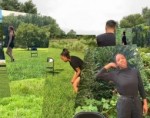
Facing Off at Jumpstart
by Lisa Kraus
The proportions of a baby’s face—big eyes, rosebud mouth—are calibrated to promote survival. They’re just so cute, we have to take care of them.How performers use their faces can determine whether we connect with them or not, or feel engaged by the art they share with us. At Jumpstart, the new Live Arts* initiative showcasing pieces in distinct genres of physical theater, dance theater and “pure” dance, a viewer could see gradations in how the face is used in each performing genre to draw the viewer in or keep them at arm’s length.
The phenomenon of performers intentionally not showing their faces has some interesting recent history. Earlier this spring at the LAB Luciana Achugar showed her newest work with its four performers’ faces veiled by knee-length, dark wigs. Trisha Brown created her solo If You Couldn’t See Me after Robert Rauschenberg challenged her to create a dance where she never faces the audience. Both of these works capitalize to the fullest on their shared conceit. In a related way, masked dances exist in many traditions; the impulse to shift how the audience reads/can’t read the face is beguiling.
Western dance has a historical tradition of a particular kind of mask—a facial neutrality that stretches back to Cunningham. Judith Dunn, a former Cunningham dancer and wife of the Judson mentor Robert Dunn, admonished me in the ‘70s to “say it with my body rather than my face.” With the postmodernists’ emphasis on an offhand performing style, the tradition of “faceless” dancing has continued. But if the performer is “inviting being seen” to borrow Deborah Hay’s term, is this default performing style a sensible convention? The Cunningham and post-modern camps made a blank face part of the “no to spectacle” era when reacting to the turgid emotional intensity of the moderns. But today, in our era of pluralism and multiplicity, the full range of presentational possibilities is available to dancers. With permission to make use of any and all strategies, “blankness” should be a conscious choice, clearly deliberate, and appropriate to the show.
Jumpstart’s three “dance theater” offerings presented performers looking out at the audience and speaking to them directly with engaging, responsive, communicative faces.
Sahar Javedani has an important story to tell. An Iranian woman who has lived for many years in the U.S., her In the Middle, somewhat aggravated reflects our stereotypes about veiled women and refers to Javedani’s being neither fully American nor fully Iranian. She begins firmly in the physical, hands curling like smoke, hair whipping like a dagger slice, letting her generous figure settle like molten lava as her feet pad downward. Then she switches performing modes, looking at us and saying “I love America” multiple times in an emotional range morphing from boosterish to desperate. Finally she holds up a laptop displaying images of veiled women and explains matter-of-factly, “I am just like you” as though speaking for all the women pictured. Sometimes the activities she describes enjoying—going to the beach, smoking, going shopping—are familiar, and sometimes the opposite: “I know to stand behind my husband.” It’s a multi-stranded portrayal, not simple.
Jamarr Hall in Dirt Roads bounced back and forth between the characters of a toothless old man mouthing his dentureless gums to an exuberant young one, eyes open with mirth, with disbelief, with terror. This is a gifted and powerful young performer whose story of remembered love and violence could use more dramaturgical clarity, but whose presence is commanding, not least because of his pliable, extremely expressive face.
The tag line for Jumpstart “showcasing the next wave of live performance” was borne out with extreme, zany promise in A Brief Cuntemplation by Ilse Zoerb. Standing at a lectern, addressing us directly, the unprepossessing Zoerb launches into a series of scenes poking serious fun at discrimination against women by delivering a speech on sexism and inserting the word “cunt” wherever it fits: “Do not be cuntent until there is cuntsistent gender equality.” She then says that she was never prey to penis envy, but rather wished for a beard. Stepping away from the lectern to expose her naked lower half, she proceeds to create a face using googly stick-on eyes and lipstick and neatly twisting her pubic hair into a mustache and goatee. Her beard indeed! As if that weren’t side-splitting enough, she dons a purpose-built costume, a kind of ball gown for that lower face with a second set of arms, and proceeds to do a soft shoe to “Honey Pie”—a sweetly choreographed divertissement for a girl and her face/snatch.
*The Live Arts Brewery is a thINKingDANCE partner, hosting meetings with writers and guest teachers.
By Lisa Kraus
June 9, 2012










